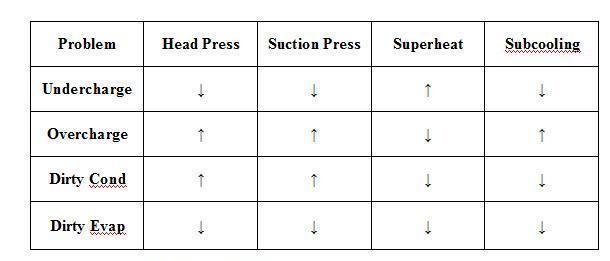
Piston and TXV sizes, AC Super heat is Here
Home
Test
Central Air PTChart
Charge R22 , Charge R410 Device
Test TargetSH
Procedures 
| _ (a) Liquid line P# => T (1) _ (b) Liquid line T | *Subcooling = (b) - (a) Add will ↑, remove will ↓ . Subcooling = [10 _ 15] |
| _ (c) Suction line P# => T (2) _ (d) Suction line T | * Superheat = (d) - (c) Add will ↓, remove will ↑. Superheat is too high=> ice built up. CCW stern of TXV to decrease superheat. And Superheat is too low=> liquid coming back compressor, damage compressor. CW stern of TXV to increase superheat . Superheat = [10 _ 15] |
| * Ambient + 30 = LSAT => Head Press (↑↓) | * 105 - Ambient = target SH (↑↓)_ |
| * (Ambient + 30)-LSAT = SC => SC (↑↓) | * Ambient + 30 = Liquid (condensing) T |
| * Lq line T below OD ambient=> HS restriction | * HS Press-LS Press>=[100_120best], or bad valves |
| * Target Superheat=105 - Ambient=[(3*IDWB)-80-Ambient]/2 (w/o chart) | * Delta T= [12_20 F] |
| *Condenser coil temp high due to non cleaning of condenser/over charged gas/non condensable gas (SH ↑) | * Home refrigerator uses around 5_6 oz of R134 |
| Non condensable gas: Low side pressure=normal, High side pressure= significant high (>300) | |
| Reserse Valve fails: solenoid coil (check voltage,fixable), stuck in heat or cool position, stuck somewhere b/t heat/cool position | |
| AC Low side = 40F; Cooler low side = 40F(room)-15=25F; | Freezer low side= -20F |
| Household fridge (134A) low side not running = [60 _ 75 ]psi depending on ambient, (running)=0 Psi,. High side> low side at least 70 Psi | |
| Oil change: vaccum, add oil high side. If bad comp, add acid first then freon | |
| Charge: <15 ': exact label amount; >15', add 0.6 Oz/ foot liquid line. Open low side king valve first to avoid oil enter TXV inside unit. | |
| TXV : =< 7/8" => 12 O'clock; >7/8' => 4 or 8 O'clock. Never and never 6 O'clock | |
_Low Subcooling is (a) not enough refrigerant in the condenser. This can be due
to undercharge, poor compression, or a metering device oversized or failing open
(overfeeding).
_ Low superheat Like an overcharge condition, low superheat means too much
liquid refrigerant in the evaporator and not enough vapor
_ High Subcooling is more than the designed amount of refrigerant is “backing
up” or “packed” into the condenser. This can be caused by overcharge,
restriction (such as a contaminated line drier or kinked liquid line), or an
undersized or failing closed metering device.
_ High superheat Possible causes include a metering device that is underfeeding,
improperly adjusted, or simply broken. Additional problems with high superheat
could indicate a system undercharge, refrigerant restriction, moisture in the
system, blocked filter-drier, or excessive evaporator heat loads.
If you are experiencing low superheat low subcooling with a TXV valve, the most
common problem is that the sensing bulb (key part of the TXV valve) is either:
If Superheat is high and sub-cooling is high: Evaporator is hungry for
refrigerant => Could
have blockage in coil, orifice or line set, or Drier filter.
If superheat is low and sub-cooling is low: Orifice could be too big, there is
no orifice in the unit of the orifice is stuck and refrigerant is by-passing it.
Superheat is telling you what is going on in the evaporator.